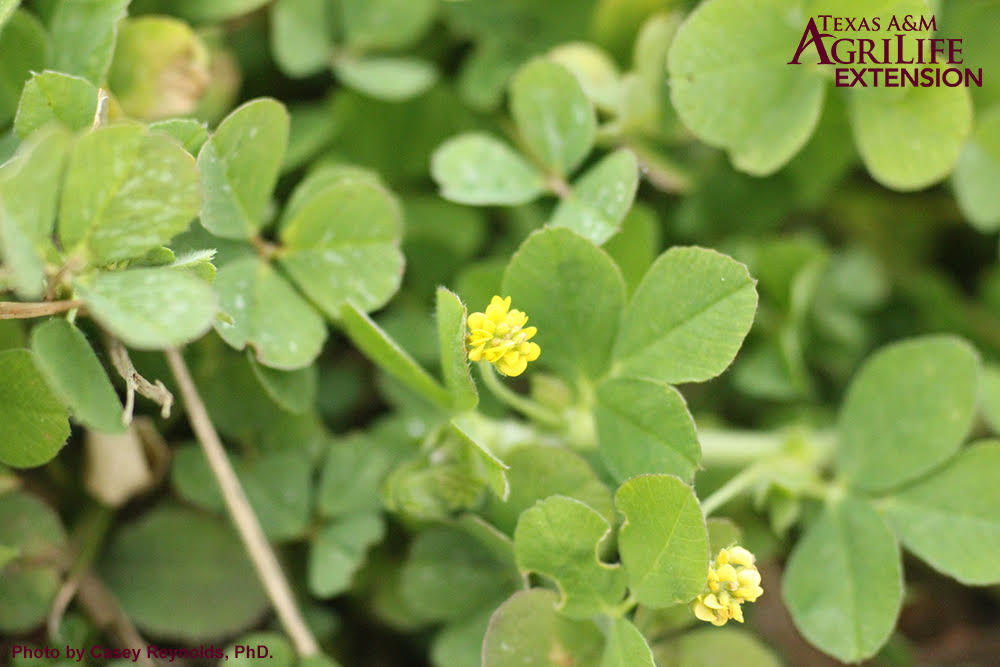By Grace Broyles
Big Country Master Gardener
Now’s the time to go barefooting through the clover in West Texas! That’s if you can find some. If you’re thinking it’s that white-flowering three-leaflet plant (that sometimes has sets of four leaves, if you are “lucky” enough to find one), you could be correct. There are a few places to find this type in our area.
But there’s another type of clover we lawn care and gardener types notice (and not for barefooting through it). It goes by the name “Burr Clover,” or “Black Medic,” or “Burr Medic.” Dog and cat owners find it annoying, and perhaps those who mow their lawns come across it at its most annoying time. Right now, however, because of the spring rains and the abundance of nitrogen that comes with the spring thunderstorms, Burr Clover is healthy and lush in many spots. Perfect for the barefoot enthusiasts, but not so for the lawn care people and gardeners.


The Burr Clover is a pretty plant with its sets of three leaflets and makes for a green carpet in areas where the soil is not very fertile, in full sun or full shade. It belongs to the very large Fabaceae or legume (think beans and peas) family of plants. Its Latin name is Medicago polymorpha and it originated in the Mediterranean Basin and Central Asia. It was brought to the United States as a foraging crop for livestock, being very nutritious as hay or as a cover crop in the winter and spring.
But watch out for the yellow flower head! This pretty little cluster of flowers will soon turn into seed pods that have hooks. In West Texas, this happens in March and continues until the extreme heat of summer arrives. When the seed pods dry up in the summer heat, the plants are not soft and wonderful for bare feet. In fact, they turn brown and crunchy and ugly, and soon are inconspicuous. The seeds that germinate after the fall rains will produce plants that will die at the first good freeze.
Understand that it doesn’t take very long after the seed pods turn brown, that these little coil-shaped seed pods come into our homes via our cats and dogs and on our shoe laces and socks. Those who raise sheep find these seed burrs a great annoyance as well, when they are caught in their sheep’s wool. The best way to deal with these seed pods is to toss them in the trash, not back out in the yard, as inside there are kidney-shaped seeds that are viable for several years. It only takes a good soaking and the seeds germinate.
But Burr Clover has its usefulness. It is seeded for soil restoration in low fertile areas, as a green manure (to be tilled into the soil), and is also great for erosion control. The root system holds the soil down very well and also provides the nitrogen neighboring plants require, such as Bermuda in a cow pasture.
Now for those of us who want a turf of exclusively Bermuda grass or St. Augustine grass, and flowerbeds clear of this uninvited clover, how do we control it?


The best way, after enjoying the barefoot softness of large plots of this plant in the spring, is to mow them down before the flowers set seeds. For individual Burr Clover plants that pop up in your beautiful turf lawns and garden areas, the best way to control them is to dig them up after a rain, or spray a broadleaf weed control product on them. Another way to treat a large area of unwanted Burr Clover is to spread pre-emergent over the area in September and again in November, or spread a corn gluten meal over the area before the plants produce flowers. It takes great persistence to rid an area of this plant.
Meanwhile, enjoy the clover while it is green and lush, admire the beauty of its flowers and its unique leaves, then do what needs to be done.
If you have any questions, call the Taylor County Extension Office at 325-672-6048 or email us at mgardeners@yahoo.com. We hope you visit bcmgtx.org for information on all Big Country Master Gardener events, like us on BCMGA Facebook, and check out training presentations on BCMGA YouTube. We are here to help you.



